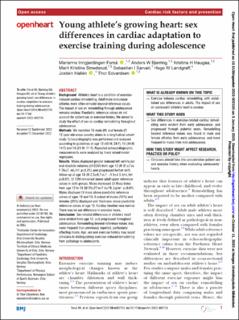| dc.contributor.author | Forså, Marianne Inngjerdingen | |
| dc.contributor.author | Bjerring, Anders W. | |
| dc.contributor.author | Haugaa, Kristina Ingrid Helena Hermann | |
| dc.contributor.author | Smedsrud, Marit Kristine | |
| dc.contributor.author | Landgraff, Hege Elisabeth W. | |
| dc.contributor.author | Hallén, Jostein | |
| dc.contributor.author | Sarvari, Sebastian Imre | |
| dc.contributor.author | Edvardsen, Thor | |
| dc.date.accessioned | 2023-10-24T08:20:06Z | |
| dc.date.available | 2023-10-24T08:20:06Z | |
| dc.date.created | 2023-09-13T10:32:53Z | |
| dc.date.issued | 2023 | |
| dc.identifier.citation | Open Heart. 2023, 10(1), Artikkel e002155. | en_US |
| dc.identifier.issn | 2053-3624 | |
| dc.identifier.uri | https://hdl.handle.net/11250/3098254 | |
| dc.description | This is an open access article distributed in accordance with the Creative Commons Attribution Non Commercial (CC BY-NC 4.0) license, which permits others to distribute, remix, adapt, build upon this work non-commercially, and license their derivative works on different terms, provided the original work is properly cited, appropriate credit is given, any changes made indicated, and the use is non-commercial. | en_US |
| dc.description.abstract | Background: Athlete’s heart is a condition of exercise-induced cardiac remodelling. Adult male endurance athletes more often remodel beyond reference values. The impact of sex on remodelling through adolescence remains unclear. Paediatric reference values do not account for patient sex or exercise history. We aimed to study the effect of sex on cardiac remodelling throughout adolescence.
Methods: We recruited 76 male (M) and female (F) 12-year-old cross-country skiers in a longitudinal cohort study. Echocardiography was performed and analysed according to guidelines at age 12 (48 M, 28 F), 15 (34 M, 14 F) and 18 (23 M, 11 F). Repeated echocardiographic measurements were analysed by linear mixed model regression.
Results: Males displayed greater indexed left ventricular end-diastolic volumes (LV EDVi) from age 12 (M 81±7 vs F 76±7, mL/m², p≤0.01), and progressed further until follow-up at age 18 (M 2.3±9.7 vs F −3.9±4.5 ΔmL/m², p≤0.01). LV EDVi remained above adult upper reference values in both groups. Males increased LV Mass Index from age 12 to 18 (M 33±27 vs F 4±19, Δg/m², p≤0.01). Males displayed LV mass above paediatric reference values at ages 15 and 18. A subset of males (35%) and females (25%) displayed wall thickness above paediatric reference values at age 12. Cardiac function was normal. There was no sex difference in exercise hours.
Conclusion: Sex-related differences in athlete’s heart were evident from age 12, and progressed throughout adolescence. Remodelling beyond reference values was more frequent than previously reported, particularly affecting males. Age, sex and exercise history may assist clinicians in distinguishing exercise-induced remodelling from pathology in adolescents. | en_US |
| dc.language.iso | eng | en_US |
| dc.subject | cardiac imaging techniques | en_US |
| dc.subject | cardiac remodelling | en_US |
| dc.subject | echocardiography | en_US |
| dc.title | Young athlete's growing heart: Sex differences in cardiac adaptation to exercise training during adolescence | en_US |
| dc.type | Peer reviewed | en_US |
| dc.type | Journal article | en_US |
| dc.description.version | publishedVersion | en_US |
| dc.rights.holder | © Author(s) (or their employer(s)) 2022 | en_US |
| dc.source.pagenumber | 9 | en_US |
| dc.source.volume | 10 | en_US |
| dc.source.journal | Open Heart | en_US |
| dc.source.issue | 1 | en_US |
| dc.identifier.doi | 10.1136/openhrt-2022-002155 | |
| dc.identifier.cristin | 2174602 | |
| dc.description.localcode | Institutt for fysisk prestasjonsevne / Department of Physical Performance | en_US |
| dc.source.articlenumber | e002155 | en_US |
| cristin.ispublished | true | |
| cristin.fulltext | original | |
| cristin.qualitycode | 1 | |
